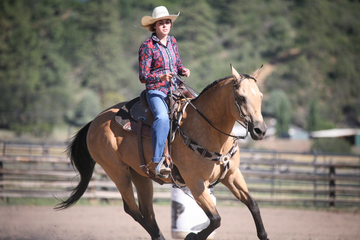
What is the difference between natural and normal horsemanship?
Firstly, I’d like to start with synonyms of the word “normal”: conventional, common, average, or accepted. All of these words can certainly lead us to the heights of mediocrity, but not far beyond.
Now, let us look at the synonyms of “natural”: there are no known synonyms. But, according to Merriam-Webster, Inc., “natural applies to what conforms to a things essential nature, function, or mode of being.” The reason Pat Parelli coined the term Natural Horsemanship was because it is natural to horses and their way of learning and being. Using these methods, we can influence horses’ behavior in the way that we want them to behave by using the laws of nature.
Horses are nature in its finest form. Working with horses is not much different than flying an airplane, surfing a wave, or sailing a sailboat. It’s the simple act of learning to play with nature’s laws rather than the rules of man.
The History of “Normal” Horsemanship
What I call Normal Horsemanship (or Traditional Horsemanship) is oftentimes predicated by the military. When horses were used in warfare, the rules created were for warfare. For example, to place your bit on tightly enough that the horse could not possibly get it out of their mouth on the battlefield (hint: this is where the “two-wrinkle” rule came from).
Have you ever wondered why you must mount your horse from the left side? This was from the military, also, because soldiers had a sword on their left hip, making it nearly impossible to mount safely from the right side.
In today’s world, nearly every chiropractor or bone-related practitioner will tell you that mounting the horse on the same side time and time again creates problems for your body.
Let’s take a deeper look at Traditional Horsemanship. Most everybody, at some point in time, was told that horses are simple if you follow these rules: Catch them anyway you can, saddle up and get on (after all, there's a pedal there for each foot), kick them to go, pull them to the stop, and finally, use the reins to turn. In comparison with the Parelli philosophy, each of these “rules” are autocratic, primitive, and shameful.
Why Natural Horsemanship?
What’s the alternative to Traditional Horsemanship practices? Natural Horsemanship. Although the name has been heard far and wide in the horse industry, there are very few people who know and practice the true art of horsemanship.
There are approximately 58 million horses in the world today, many of which are “ownerless”, and many are one of multiple horses under one owner (making the number of horse owners far smaller than the total number of horses). Regardless of the number, however, it is astonishing how few of those involved in horses are real horseman.
If we compare the above Traditional Horsemanship “rules”, here’s what Natural Horsemanship provides the function to do: Create a connection with the horse where he seeks to be with you, play on the ground (i.e. horseplay) before mounting your horse, use energy and squeeze to go, lift to stop, and finally, look to turn.
Tom Dorrance was one of, if not the most, extraordinary horsemen in the world. Horses responded to him differently than anyone else because there was something special about his attitude, his feel, his timing, and his balance. He was once at a clinic doing a demonstration very methodically. As he slowly worked with a horse, amazing results started to happen quickly. Two ladies were in the grandstand. One looked at the other and said, “That looks like magic.” The other, under her breath, replied “I think it’s supernatural.” Tom Dorrance looked up said, “No ma'am. It's not magic. It's not supernatural. This is supremely natural.”
Here at Parelli Natural Horsemanship, we call this Savvy. Savvy is what horses pick up on naturally: knowing when to be, where to be, why to be, what to do when you get there, and when to quit doing what you’re doing.
For horses, Savvy comes naturally. For humans, Savvy is learned. That’s why we created the Savvy Club: Parelli Natural Horsemanship’s monthly membership that teaches you from the ground up how to build a lasting partnership with your horse. Check it out today.





